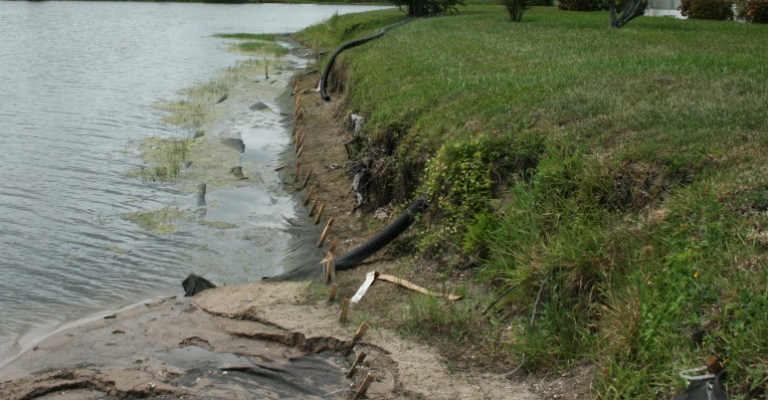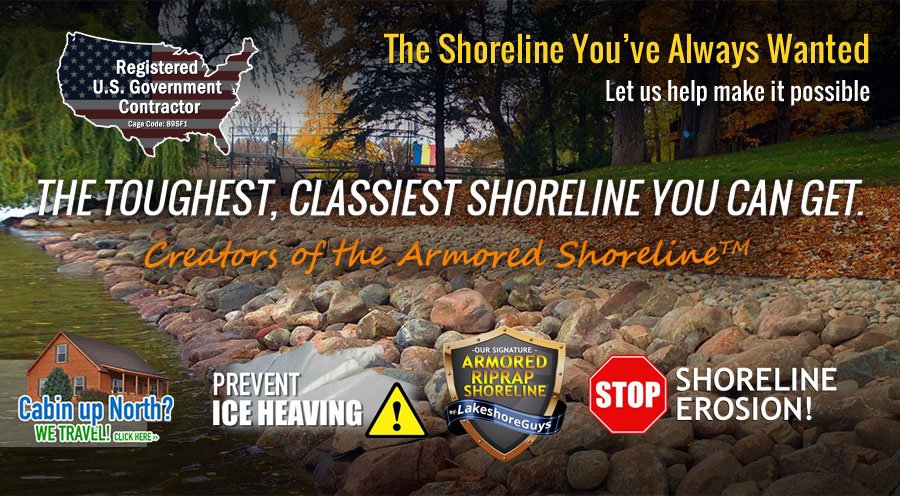Shoreline Restoration Fabric: Does the Type Matter?

You may think it’s just fabric. How much of a difference can it really make?
Quite a bit. The fabric is the backbone of your shoreline, and largely determines whether your riprap stands or collapses. If the shoreline company you hire does not use high-quality fabric to complete your project you will waste time and many thousands of dollars.
What’s the purpose of fabric in your shoreline?
Fabric goes under the riprap to prevent soil erosion. Erosion control is why most people consider riprap shorelines in the first place.

But the riprap itself is not what prevents erosion. Riprap displaces wave energy, and helps to combat ice jacking. The main purpose of the riprap itself is merely to hold the fabric in place on the slope of your shoreline. You don’t see the fabric, but it’s crucial. If riprap is the house, fabric is the foundation.
Experts use two basic types of fabric: woven and non-woven
A woven fabric is simply any textile structure produced by interlacing (i.e., weaving) two or more sets of strands at right angles on a warp and weft. Imagine grandma knitting you a fresh pair of socks.
Non-woven fabric is a touch more complicated. There are actually two kinds of non-woven fabrics that are commonly used in the industry:
- Non-woven needle punch or filter-fabric is a textile structure produced by using barbed needles to mechanically entangle fibers in a preformed dry, fibrous web.
- Non-woven spun-bonded fabric (aka Spunbond and Spunbound fabric) is a textile produced by the process of extruding thousands of tiny filaments onto a collecting belt and then applying heated rolls to the surface of the belt to bond the filaments in place.
So which fabric is the best for your shoreline, and why?
Needle punch filter-fabric is the only fabric that should ever be used in a riprap shoreline.
First, it has gorilla-like strength. That’s important because it will need to support many tons of riprap.
Second, it is puncture-resistant. Puncture resistance is worth concerning yourself with, because riprap is made out of rocks, and some of those rocks can have jagged edges.
Third, it allows water and gasses to flow through it on a bidirectional horizontal plane. These are two of the forces of nature that are at work on a shoreline, and you can either work with them or against them. I suggest working with them, since Mother Nature always wins in the end. So what do these two forces want to do?
- Groundwater on the landward side of your shoreline wants to bleed through your shoreline and into the lake. You need a fabric that will allow that to happen, rather than fight it by holding the water back. The groundwater will simply find a path down the backside of your shoreline. It will still get to the lake, but it will take your shoreline with it a few granules at a time. That’s the very erosion you’re trying to prevent.
- Waves roll in from the waterward side of your shoreline, where they pound constantly against your riprap. There will be less impact on your shoreline if some of the water (along with its force) is absorbed and/or allowed to bleed through the fabric. If you use the wrong type of fabric, you’ll simply stop every wave in its tracks. Eventually Lady Lake will win this grudge match and she will rip into the fabric simply by battering your riprap through the fabric.
You can see why allowing water and gasses to travel through fabric is so important.
Fourth, needle punch filter-fabric is UV-resistant. Ultraviolet rays may break down your fabric. This is referred to as “reflective cracking.” So, because don’t trust the fabric alone to resist UV rays, we cover as much of the fabric as possible with riprap.
Fifth, when needle-punch filter-fabric stretches the holes don’t expand much. I’m talking about microscopic openings in the fabric particles themselves. You can stretch and stretch and stretch and these microscopic openings won’t increase in size nearly as much as they will in other types of fabric. That’s good, because if you could noticeably increase their size you’d see a lot more erosion. All Mother Nature really needs is an opening the size of a grain of sand. Remember, thousands of waves gently roll into (or crash into) your shoreline each and every day. With each wave, a few grains of your shoreline go for a swim.
To help illustrate why you should always use needle-punch filter-fabric beneath riprap, perform this simple DIY experiment at home:
- To simulate woven fabric, grab one of those socks your grandmother knitted you. Hold it up to the light and stretch it with all your might. Notice how the openings between each thread of yarn become larger. Now, imagine 30+ tons of riprap getting dumped on top of a fabric sheet made just as the sock was made. The openings will get much bigger. Sand and soil travel through them. That’s why you don’t use woven fabric on shorelines.
- To simulate non-woven fabric (specifically, needle-punch filter fabric) grab an old flannel shirt. Hold it up to the light and once again stretch it with all of your might. Notice how you can’t ever see a change in the amount of light coming through the shirt. This is exactly what you’d see with a premium needle-punch fabric, even after 30+ tons of riprap is plopped on it. Although the fabric will stretch, it won’t tear or rip, and the openings between those tens of thousands of fibers will remain roughly the same size. That means your soil is kept behind your riprap, where it belongs.
Hey, you pay taxes on all that shoreline. You might as well keep it all.
Note, Spun-bonded fabric is also a non-woven fabric, but it should never be used on a riprapped shoreline. Although it does a wonderful job of fighting erosion, its elasticity is nearly zero – meaning it doesn’t stretch. Because it won’t stretch it will rip and tear easily, especially after we pile tons of rock on top of it. The slightest hole, tear, or rip will gradually cause the demise of your newly riprapped shoreline.
Weight matters too.
It’s not enough to get out there with needle-punch filter-fabric. You want to use the right weight, too. The heavier this stuff is, the better it withstands Lady Lake.
Needle-punch filter-fabric comes in 2 oz., 4 oz., 6 oz., and 8 oz. thicknesses. You have to go to specialty fabric supply outlets to get the 8 oz. fabric, which means you have to go the extra mile.
I’ll let you guess which fabric weight we use.



